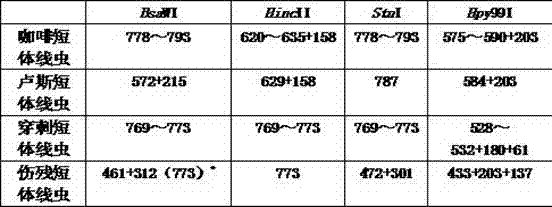PCR-RFLP method for distinguishing four types of pratylenchus
A short-bodied nematode and nematode technology, applied in the field of PCR-RFLP, can solve the problems of complicated operation, inconsistent results, loss of specificity of specific primers, etc., and achieve the effects of simple operation, stable results and wide application prospects.
- Summary
- Abstract
- Description
- Claims
- Application Information
AI Technical Summary
Problems solved by technology
Method used
Image
Examples
Embodiment
[0013] The PCR-RFLP method to distinguish 4 species of Brachytematodes, the specific steps are as follows:
[0014] 1. DNA extraction: add an appropriate amount of sterilized double distilled water on a sterilized clean glass slide, and use a sterilized 0 gauge needle
[0015] The worms of the genus Brachyma are picked in water droplets for washing, and then the worms are picked up with 10μl of double distilled water (ddH 2 O) Microcentrifuge the sterilized PCR tube and place it in an ultra-low temperature refrigerator -80℃ for 29~31 min. After taking it out, keep it at 85℃ for 5 min, and then immediately reduce the temperature of the PCR tube to 56℃. Constant temperature for 30 S, add 2μl of proteinase K solution (purchased from TaKaRa) and 10×EasyTaq buffer 5μl (purchased from TRANS) with a concentration of 1 mg / mL to the PCR tube. The PCR tube is first kept at 56°C for 1 h , Then keep it at 95℃ for 15 min to obtain the DNA extract, and store it at -20℃ for later use;
[0016] 2. ...
PUM
 Login to View More
Login to View More Abstract
Description
Claims
Application Information
 Login to View More
Login to View More - R&D
- Intellectual Property
- Life Sciences
- Materials
- Tech Scout
- Unparalleled Data Quality
- Higher Quality Content
- 60% Fewer Hallucinations
Browse by: Latest US Patents, China's latest patents, Technical Efficacy Thesaurus, Application Domain, Technology Topic, Popular Technical Reports.
© 2025 PatSnap. All rights reserved.Legal|Privacy policy|Modern Slavery Act Transparency Statement|Sitemap|About US| Contact US: help@patsnap.com

